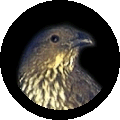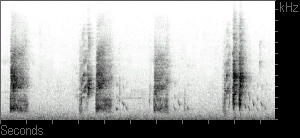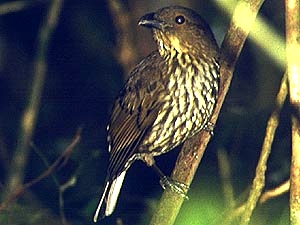 Tooth-billed
Bowerbird
Tooth-billed
Bowerbird Scenopoeetes dentirostris
 Figure 1. Spectrogram of the Tooth-billed Bowerbird
song.
Figure 1. Spectrogram of the Tooth-billed Bowerbird
song. (The first 10-seconds from the sound file are depicted.)

Tooth-billed Bowerbird - Scenopoeetes dentirostris
Adult male tooth-billed bowerbirds clear small areas on the rainforest floor, often in the shape of a ring around the trunk of a tree. Upon the cleared land, a male will place oblong green leaves with the pale side of the leaves facing upwards. This circular area is called his ‘display court’, and it is a mating arena where copulation takes place. Each male meticulously maintains his display court throughout the four-month breeding season (October through January), keeping the court free from all objects except the fresh green leaf decorations he places there. This unusual habit has earned the tooth-billed bowerbird the nickname ‘the stagemaker’.
The courtship of tooth-billed bowerbirds has two distinct phases. Initially, a male sings advertisement songs from a concealed perch high above his display court. Advertisement songs are given in long song bouts, with songs given at a rate of approximately one song every 7.5 seconds. These songs begin as hoarse snarls, which have an unpleasant, grating character. However, advertisement songs often end with short, quiet whistled notes (e.g. the second, third, and fourth songs in figure 1). Tooth-billed bowerbirds are good vocal mimics, and advertisement songs may include imitations of the songs of bower’s shrike-thrushes, mountain thornbills, or other birds that share their rainforest habitat. While advertising to attract females, males will engage in countersinging contests with neighbouring males, where they have been heard to match the type of song that their opponent is singing (S. Doucet personal observation).
The second phase of courtship occurs when a female tooth-billed bowerbird arrives at the display court. Males fly down to their circular stage and begin an erratic dance. With wings spread, the male lunges around his display court with neck feathers erected and mouth agape. With his mouth open, the male tooth-billed bowerbird exposes the white-coloured interior of his lower mandible for which this species is named. If a female is sufficiently impressed with the male’s song, display court, and courtship dance, she will copulate with him.
Habitat.
Throughout the breeding season, these birds are found in tropical rainforest, although they will stray to areas surrounding rainforest at other times of year.
Range.
Tooth-billed bowerbirds are endemic to forests at higher elevations in northeast Queensland.
Further Reading.
C. B. Frith & D. W. Frith. 1993. Courtship display of the tooth-billed bowerbird and its behavioral and systematic significance. Emu. 93:129-136.
C. B. Frith & D. W. Frith. 1995. Court site constancy, dispersion, male survival and court ownership in the male tooth-billed bowerbird. Emu. 95:84-98.
C. B. Frith & McGuire, M.
1996. Visual
evidence of vocal avian mimicry by male tooth-billed bowerbirds. Emu.
96:12-16.
No recordings, photographs, or other information may be used without written permission (email me at dmennill AT uwindsor DOT ca).